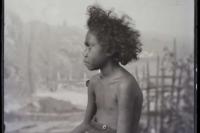The Indigenous community on Palm Island in far north Queensland will feature in an historical documentary about a relatively unknown aspect of colonisation.
Up to 20 Aboriginal people were taken from northern Australia in the 19th and 20th centuries to be exhibited alongside animals in what was called The Human Zoo. Along with tens of thousands of other people, they were put on display across Europe and North America until at least 1940. The Palm Island community has been reunited with the remains of one of its ancestors involved in the trade.
Palm Island elder Walter Palm Island said it was a privilege to meet the remains of an ancestor, found mummified in North America, back on home soil. "My father's genealogy shows that an uncle died in America in a circus ... and it was like a jigsaw puzzle putting these pieces together," he said.
"Looking at the images and pictures of the ancestors, I can see the pain and suffering they had in the expressions on their face. And how degraded they were.
"They lost a lot of their self-esteem and confidence in themselves as human beings. They were treated as animals."
Mr Palm Island's ancestor died in the late 19th century — he was one of about 35,000 people who were exhibited in human zoos between the early 1800s and World War II.
"They were displayed as cannibals. Man eaters. The missing link between man and monkey, for audiences in search of exoticism and the thrill of the unknown," he said.
Philip Rang, an Australian cinematographer, is working on a documentary that retraces some of these human stories and has just returned from filming on Palm Island.
He said about 20 Aboriginal people were taken from there and Ingham in north Queensland. "It's absolutely astonishing [there is] little known about this story," Mr Rang said. "They didn't know what was going on. They were lured away by a clever, say, white fella.
"They first got loaded up in Townsville and taken down to Sydney. And so they wouldn't escape, they were stripped of all their clothes and put on a boat."
Not a political film, a human story
The human zoos also exhibited people from Africa, the Pacific and Asia.
Mr Rang said it was a justification for colonisation.
"They would travel to faraway lands and say look at what we discovered. Not only have we found spices and herbs and raw materials, but we also found these peoples."
One of the documentary's directors, Bruno Victor-Pujebet, hopes it will discourage a repeat of history. "We have lots of images, pictures and old films — it's important to give the public the historical context," he said.
"It was the way to justify the domination of the world. These people victim of that. But we don't want to make a political film, we just want to give the facts and tell the story of these people who were completely forgotten."
For Mr Palm Island, the documentary is a chance for his people to build a greater sense of identity.
"Australian Aboriginal history hasn't been told and the plight of Australian Indigenous people and what really happened to them," he said.
The documentary will be first shown in France in June.

